Courses: Introduction to GoldSim:
Unit 16 - Creating Dashboards and Player Files
Lesson 4 - Creating, Viewing and Running a Player File
As pointed out in Lesson 2, a GoldSim model can be saved as a Player file. Player files can be opened using the GoldSim Player, which is a free download. As a result, Player files can be modified (via Dashboards) and run without having a licensed version of GoldSim. This allows you to easily distribute your model to clients, managers, regulators and other stakeholders.
In this Lesson, we are going to create, view and run a Player file.
If it is not already open, open the file with the Dashboard that you created in the previous Lesson.
To create a Player file, select File|Save Player File… from the main menu. The following wizard dialog will be displayed:
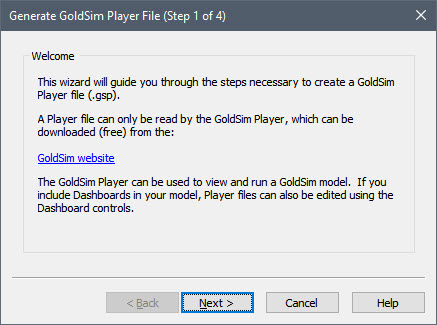
Press the Next button:
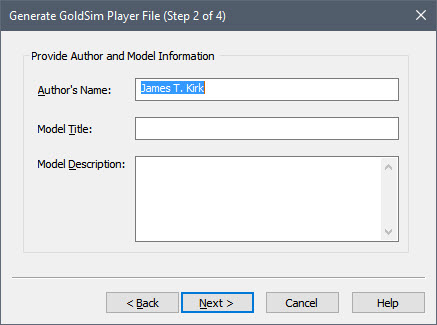
The second page of the wizard prompts you for the Author’s Name, a Model Description, and a Model Title. The Author’s Name, Model Title, and Model Description can be viewed via a menu item in the Player. The Model Title also appears in the title bar of all Dashboards. Enter a short Title (“Evaporating Pond”) and a brief Description (“Simple evaporating pond model”).
Press the Next button:
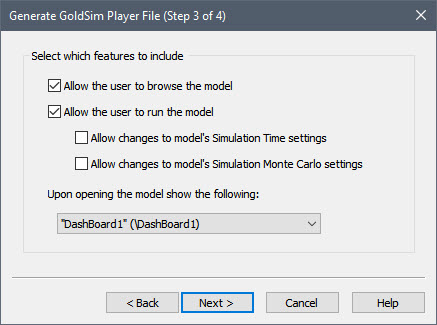
The third page of the wizard allows you to specify the properties of the Player file:
- If the Allow the user to browse the model option is checked (the default), the Player user is allowed to leave any Dashboard(s) and browse the structure of the model. Clear this box now.
- If the Allow the user to run the model option is checked (the default), the buttons in the Run Control toolbar within the Player will be available to run the model. If this option is off, the buttons in the Run Control toolbar will be grayed out and the Player user will be able to view the model, but will not be able to run it. Leave this at the default value (checked).
If the user can run the model, you can also specify whether or not they can access the Simulation Settings. Leave these at their default values (cleared).
The final field on the third page of the wizard determines what will be displayed when the Player user opens the file. The drop-list contains all Dashboards in the model. If the model is browsable, it also contains “Top-level Container”. In our case, we want the Player file to open to the one Dashboard we have in the model, so we will leave this option unchanged also.
Press the Next button:
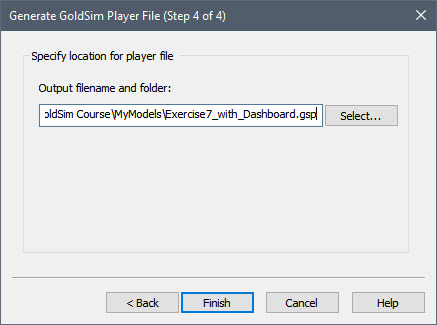
The final page of the wizard is used to specify the path and filename of the Player file. The extension of the Player file must be .gsp. If this is left out, GoldSim automatically adds this extension when it creates the file.
Press Finish and GoldSim will save the Player file.
We will revisit this model again, so before doing anything else, save it now.
Now that we have created the Player file, let’s open it. Note that the Player file has a different extension (.gsp) from the GoldSim model file (.gsm). You cannot open a Player file using GoldSim. You can only open a Player file using the GoldSim Player. When you install GoldSim, the Player is automatically installed along with it. For others who do not have GoldSim installed, an installation file for the Player can be downloaded from the GoldSim website (and the Player can be installed and run without purchasing a license).
Once the Player is installed, we can open a Player file in two ways:
- We can open the Player, and then (via a button or a file menu) open the Player file; or
- We can simply double-click on the Player file itself.
For now, we will do the latter.
To do so, first save and then minimize the GoldSim file we have been working with. Now browse to the folder (using File Explorer) where you saved the Player file (presumably, MyModels). If you do that, you will see that the Player file has a slightly different icon than the model file:

In particular, you will note that the icon for a Player file is green (rather than blue). Double-click on that file now and it will open the file in the GoldSim Player:
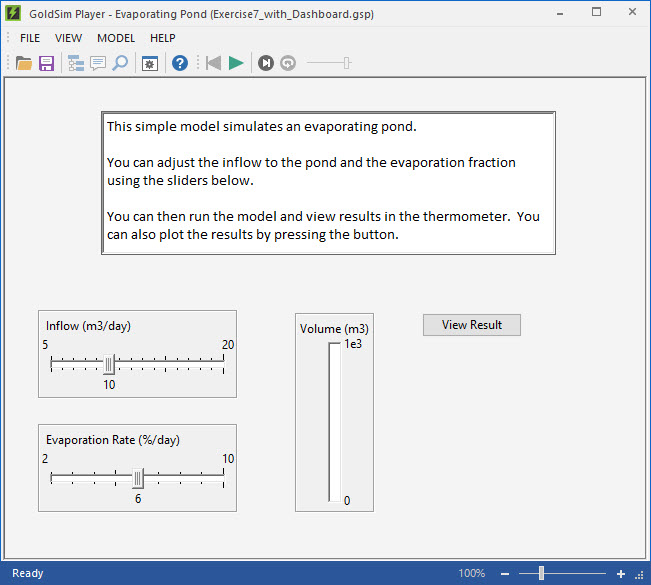
As can be seen, the Player is a simplified version of GoldSim. The Dashboard we just created in the previous Lesson forms the entire user interface. There are also two toolbars available at the top of the window (the Standard toolbar and the Run Control toolbar).
If you hold your cursor over the various controls, you will see that the tool-tips that we defined will appear. You can also move the two sliders to adjust their values.
Now let’s run the model by pressing the Run button in the toolbar. The “Simulation Complete” message will appear (and the status bar will turn green, indicating that the model is in Result Mode). The thermometer control shows the final value for the volume in the pond:
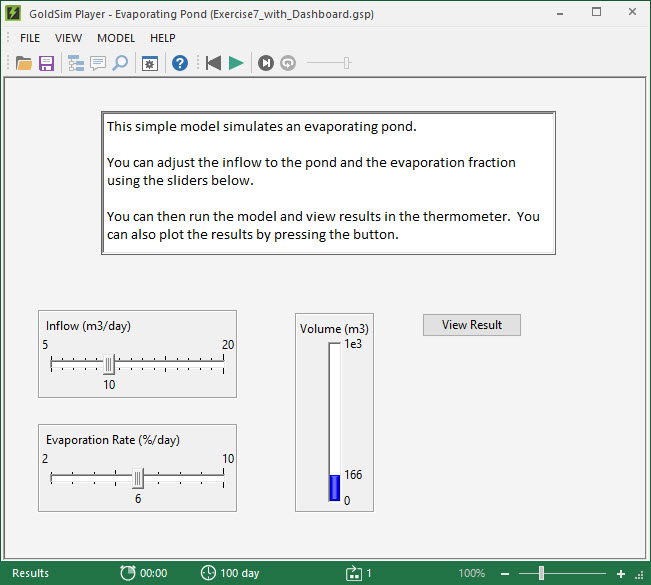
If you press the “View Result” button, the time history result will be displayed:
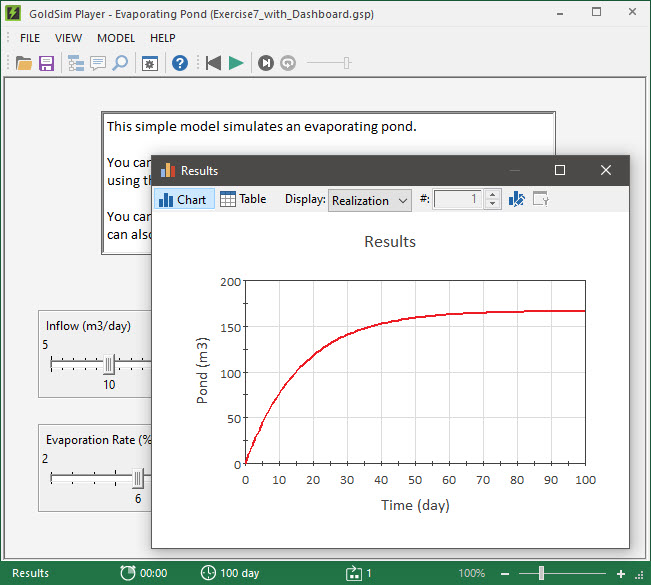
Now close the result plot, and let’s change the value for the Inflow. When you try to do so, you will see you cannot:
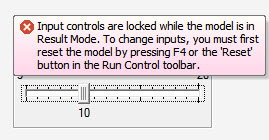
As pointed out in the tool-tip, in order to change inputs, we first must delete the current results, by pressing F4 or the Reset button in the toolbar. Do that now, change the Inflow, and rerun the model.
It should be clear from this very simple Player file that, from the user’s point of view, a Player file appears to be a custom application (in this case, to simulate an evaporating pond). They don’t need to know anything about GoldSim to change the inputs and run the model. Any instructions required can be provided via tool-tips and text (e.g., if desired, we could have provided additional instructions in a Text Box for running the model).
You can leave the Player file open, as we will discuss it a bit more in the next Lesson.
